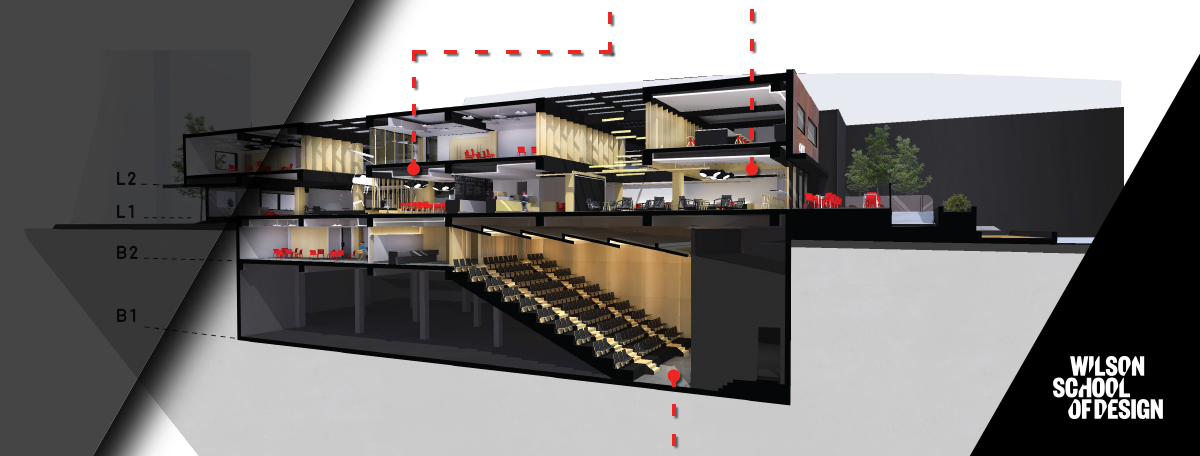
Our Bachelor of Interior Design and Bachelor of Interior Design (Honours) programs are all about experimenting, discovering, problem-solving, and innovating. Our students learn by doing, by immersing themselves, by pushing the boundaries, by challenging the notions of failure, and by delving deep into the design process. We think this makes them great designers and we know this has earned our program wide respect within the industry.
Our classes are purposefully small which allows our students a close connection with faculty. This in turn creates a strong community of talented and passionate designers. And this is why we’re one of a select group of Council for Interior Design Accreditation (CIDA) accredited undergraduate programs in Canada.
The Bachelor of Interior Design (Honours) is the first in western Canada. Students in the program may now declare an intention to apply for an Honours Degree in their third year of the program. As one of a small handful of Interior Design Honours programs in Canada, we are excited to offer this exciting new pathway.
Our Bachelor of Interior Design program is a full-time, four-year undergrad focused on the built environment. Our program curriculum is integrated and content is interwoven throughout all four years. Our course content streams are organized into the following:
- Studio: The heart of our program where students experiment, research, define, apply learning from other streams, and produce solutions to design problems. Interwoven and integrated into the Studio is the critical awareness of history, theories, and methodologies. Our Studios mimic a design firm where feedback, communication, teamwork, and mentoring is encouraged. This is where students learn methods for creative and critical thinking. This is where they learn the design process in-depth.
- Building Technologies: As in our Studio, students learn and synthesize the vocabulary, technical skills, and technical knowledge specific to interior architecture. Students become familiar with structure and building codes, circulation, drafting principles, and diagramming which are then integrated within Studio projects.
- Design Communication: Seeing, thinking, and drawing (by hand or digitally) are interrelated. Students explore how design ideas are communicated visually to clients. This is also where students find their unique expression and discover their design process.
- Site Studies: In order to learn essential observation skills, students travel outside of the classroom to see projects in progress or completed. This is also where students learn to measure and document, where history meets the contemporary, and where global differences in design inform their decisions. Importantly, students also discover innovative materials and components that are essential for ‘real-world’ application.
- Professional Practice: Even the most talented designers cannot launch a career without knowledge of office policies and procedures, business ethics, global issues, sustainability practices, and legal issues. Students study the practice of interior design and learn how to better transition from school to the workplace. An integral part of this professional study is the integration of a Professional Work Experience where students put theory to practice in a design firm under a Registered Interior Designer.
- Liberal Education Electives: We want our students to become well-rounded and thoughtful members of society. Our graduates are culturally literate and can place their design practice in context by drawing on a thorough knowledge base and critical thinking skills. Liberal education is an important component in rounding out skills.
Click HERE for a printable version of our Program Model.
To ensure that every student is set up for success, we also support students with the following resources:
- Industry Support: professional experience, professional critiques, workshops, connection to industry events, and vendor visits.
- Design Lab/Tech Hub: product samples, product databases, computers, scanners, plotters, 3D printers, laser cutters, and print resources.
- Workshop: hand tools, power tools, and drafting equipment.
- Learning Supports: online databases, librarians versed in design resources, educational and personal counsellors, and tutors.
- International Opportunities: semester abroad and out-of-university travel experiences including an integrated Design Field School.
You’ll graduate with the credentials required by our professional association, IDIBC, to become an intern member, along with the robust portfolio and the industry connections you’ll need to launch your career. To take your first steps, APPLY NOW.
"The CIDA reaccreditation confirms the rumour is true: KPU offers one of the best interior design programs in Canada! It takes a bold, committed and confident department to voluntarily put their curriculum up for review by an independent review panel. Given the majority of evidence analyzed by CIDA is previous student work, this reaccreditation also proves KPU successfully translates academic theory into applied design skills. Past performance is the best indicator of future achievements; I look forward to many more success stories. Many thanks to everyone in the KPU Interior Design department!"
Taryn Chisholm, Alumni
Design Principal - West Acre, Victoria, BC